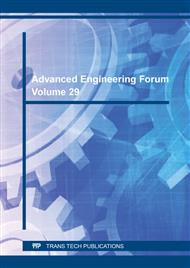[1]
https://en.wikipedia.org/wiki/Alpha_wave.
Google Scholar
[2]
Jazizadeh Farrokh, Ahmadi-Karvigh Simin, Becerik-Gerber Burcin, Soibelman Lucio, 2014, Spatiotemporal lighting load disaggregation using light intensity signal, Energy and Buildings 69 (2014) 572–583.
DOI: 10.1016/j.enbuild.2013.11.040
Google Scholar
[3]
International Commission on Illumination, CIE, 2010. Lighting of Roads for Motor and Pedestrian Traffic, CIE Public 115, Vienna, Austria.
DOI: 10.25039/tr.115.1995
Google Scholar
[4]
Peoa-Garcia, A., 2008. In: Iluminacion y seguridad: Proceedings of the Congreso Nacional de Medio Ambiente (CONAMA), Madrid.
Google Scholar
[5]
Tien, J.M., O'Donnell, V.F., Barnet, A., Mirchandani, A., Pitu, B., 1977. Street lighting projects. National Evaluation Program, Phase 1 Summary Report. National Institute of Law Enforcement and Criminal Justice, Washington DC, USA.
Google Scholar
[6]
Welsh, B. P., & Farrington, D. C. (2008). Effects of improved street lighting on crime. Campbell Systematic Reviews, 13.
Google Scholar
[7]
Antal haans, Yvonne A.W. de kort, 2012 , light distribition in dynamic street lighting: two exprimental studies on its effects on perceived safty , prospect, concealment, and escape.
DOI: 10.1016/j.jenvp.2012.05.006
Google Scholar
[8]
Alan T. Murray, Xin Feng, 2015, Public street lighting service standard assessment and achievement, science direct.
Google Scholar
[9]
Painter, K.A., Farrington, D.P., 1997. The crime reducing effect of improved street lighting: the Dudley project'. In: Clarke, R.V. (Ed.), Situational Crime Prevention: Successful Case Studies, second ed. Harrow and Heston, Guilderland, N.Y., pp. 209–226.
Google Scholar
[10]
Painter, K.A., Farrington, D.P., 1999. Improved street lighting: crime reducing effects and cost-benefit analyses. Security J. 12, 17–32.
DOI: 10.1057/palgrave.sj.8340037
Google Scholar
[11]
Gomez-Lorente, D., Rabaza, O., Espion Estrella, A., Peoa-Garcia, A., 2013. A new methodology for calculating roadway lighting design based on a multiobjective evolutionary algorithm. Expert Syst. Appl. 40, 2156–2164.
DOI: 10.1016/j.eswa.2012.10.026
Google Scholar
[12]
van Bommel WJ. Non-visual biological effect of lighting and the practical meaning for lighting for work. Appl Ergon, 2006;37:461-466.
DOI: 10.1016/j.apergo.2006.04.009
Google Scholar
[13]
Park YunHee, 2015, Color temperature's impact on task performance and brainwaves of school-age children , Published online 2015 Oct 30.
Google Scholar
[14]
Deguchi T, Sato M. The effect of color temperature of lighting sources on mental activity level. Ann Physiol Anthropol 1992;11:37-43.
Google Scholar
[15]
Palva S, Palva JM. New vistas for alpha-frequency band oscillations. Trends Neurosci 2007; 30:150-158.
DOI: 10.1016/j.tins.2007.02.001
Google Scholar
[16]
Jin Young Park1,2, Ra-Yeon Ha1,2, Vin Ryu3, Eosu Kim1,2, Young-Chul Jung, 2013, Effects of Color Temperature and Brightness on Electroencephalogram Alpha Activity in a Polychromatic Light-emitting Diode.
Google Scholar
[17]
Badia P, Myers B, Boecker M, Culpepper J, Harsh JR. Bright light effects on body temperature, alertness, EEG and behavior. Physiol Behav 1991;50:583-588.
DOI: 10.1016/0031-9384(91)90549-4
Google Scholar
[18]
OECD/IEA (Organisation for Economic Co-operation and Development/International Energy Agency). World energy outlook 2006. France: OECD/IEA; (2006).
DOI: 10.1093/law:epil/9780199231690/e1722
Google Scholar
[19]
Mie, G., 1908. Beitruge zur Optik trüber Medien, speziell kolloidaler Metallosungen. Ann. Phys. 25, 377–455.
DOI: 10.1002/andp.19083300302
Google Scholar
[20]
Iqbal, M., 1983. An Introduction to Solar Radiation. Academic Press.
Google Scholar
[21]
Raynham, P., Saksvikronning, T., 2003. White light and facial recognition. Light. J. 68, 29–33.
Google Scholar
[22]
Painter, K.A., 2009. The Cornwall project. A New Approach to Evaluate the Impact of Public Lighting on Carbon Reduction, Crime, Community Safety, Quality of Life, Environment and Policing. University of Cambridge, Institute of Criminology.
Google Scholar
[23]
An-Seop Choia, Young-Ook Kima, Eun-Suk Oha, Yong-Shik Kim, 2005, Application of the space syntax theory to quantitative street lighting design.
Google Scholar


